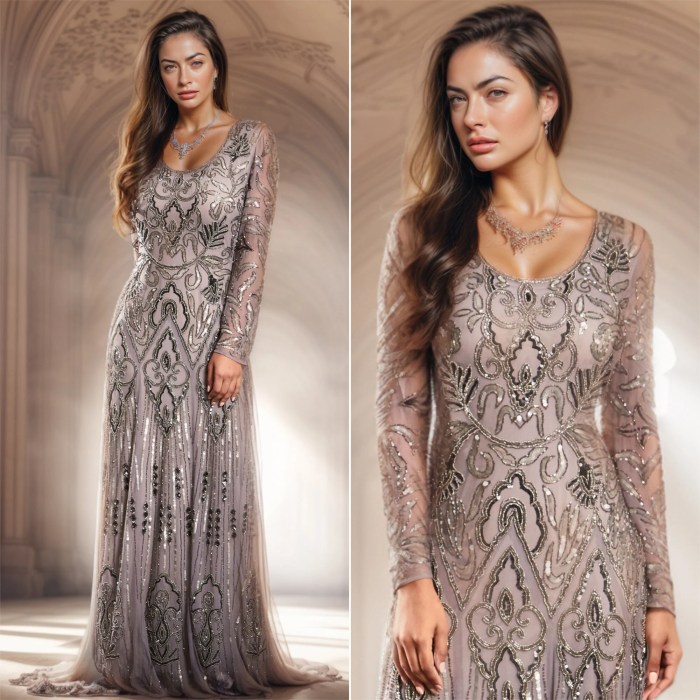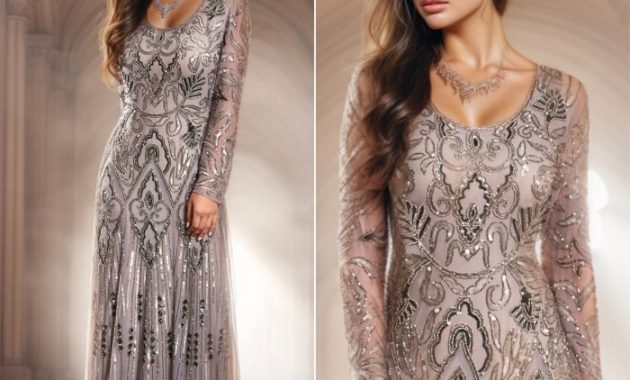1920s Plus-Size Wedding Dresses: A Timeless Elegance
1920s wedding dress plus size – The roaring twenties witnessed a shift in fashion, embracing a newfound freedom and flapper-inspired styles. However, the representation of plus-size women in this era’s fashion remains limited in historical documentation. This exploration delves into the styles, social context, and modern interpretations of 1920s plus-size wedding dresses, offering a glimpse into a largely undocumented aspect of bridal history.
Styles of 1920s Plus-Size Wedding Dresses, 1920s wedding dress plus size
While photographic evidence specifically showcasing plus-size 1920s wedding gowns is scarce, we can extrapolate from the general fashion trends of the era. Plus-size gowns likely adapted the prevailing silhouettes and fabrics, albeit with adjustments for fit and comfort.
Silhouette variations popularized in the 1920s, adapted for plus-size figures, would have included empire waists, which emphasized the narrowest part of the torso, and A-line dresses, which offered a flattering, flowing shape. Dropped waistlines, another defining feature of the decade, would have also been incorporated, creating a longer, leaner appearance. Full skirts were common, often made from lightweight fabrics to avoid overwhelming the wearer.
Common fabrics included lightweight silks such as charmeuse and crepe de chine, as well as softer materials like georgette and lace. These choices provided both elegance and breathability, essential considerations for warmer weather weddings or indoor events.
Embellishments and detailing varied, reflecting the opulent tastes of the time. Beading, sequins, and embroidery were frequently used, adding sparkle and texture. Lace appliqués and delicate floral motifs also provided intricate detailing. The use of these embellishments would have likely been more restrained on plus-size gowns to avoid adding bulk or detracting from the overall silhouette.
| Style | Silhouette | Fabric | Defining Characteristics |
|---|---|---|---|
| Empire Waist Gown | Fitted bodice just below the bust, flowing skirt | Charmeuse, crepe de chine | Emphasis on the narrowest part of the torso, creates a lengthening effect |
| A-Line Gown | Fitted at the shoulders, gradually widening to the hem | Georgette, lace | Flattering and comfortable, versatile style |
| Dropped Waist Gown | Waistline sits below the natural waist | Silk crepe, satin | Creates a longer, leaner appearance; often paired with a full skirt |
Historical Context and Social Influences
Societal norms surrounding plus-size women in the 1920s were complex and often restrictive. The ideal of feminine beauty leaned towards a slender figure, reflecting the overall fashion trends. However, plus-size women were not entirely absent from society; they participated in social events and undoubtedly wore wedding attire. The available imagery, however, tends to focus on the prevailing slimmer ideals.
These norms influenced wedding attire choices in that plus-size brides likely adapted prevailing styles to suit their figures, employing strategies such as strategic draping, clever use of embellishments, and selecting fabrics that draped well. They may have also chosen less revealing necklines or sleeve styles to conform to social expectations.
While specific photographs of plus-size brides from this era are rare, one can imagine a bride in a beaded dropped-waist gown, the skirt softly flowing around her, perhaps with a simple, elegant veil. Another might wear a lace A-line gown with long sleeves, showcasing delicate embroidery and a modest neckline. These imagined scenarios highlight the potential for elegant and flattering wedding attire, even within the constraints of the time.
Comparing 1920s and contemporary plus-size bridal fashion reveals a significant shift. Modern plus-size bridal wear offers a much wider range of styles, sizes, and designs, celebrating body diversity and providing options that flatter various figures. The focus has shifted from concealing curves to celebrating them.
Modern Interpretations of 1920s Plus-Size Wedding Dresses
Modern designers can draw inspiration from the elegance of 1920s styles while adapting them for contemporary plus-size figures, ensuring both style and comfort. This involves a careful consideration of fabric choice, silhouette, and detailing.
Design 1: A modern empire waist gown in a luxurious silk crepe, featuring delicate beading along the neckline and a flowing, A-line skirt. The beading adds subtle sparkle without overwhelming the silhouette.
Design 2: A dropped waist gown in a rich velvet, showcasing a deep V-neckline (moderately plunging, but still elegant) and long, flowing sleeves. This design emphasizes the elegance of the silhouette without being overly revealing.
Design 3: A sleek A-line gown in a shimmering satin, featuring a simple, elegant neckline and a subtle train. The satin fabric creates a flattering drape, while the minimal detailing keeps the look sophisticated.
Key design elements from the 1920s that translate well include the use of flowing fabrics, the dropped waistline (when appropriate), and the incorporation of subtle embellishments. The emphasis on flattering silhouettes remains crucial.
Adapting vintage styles requires careful consideration of the fabric weight and drape, ensuring the garment falls gracefully and comfortably. Modern construction techniques and pattern making can accommodate plus-size figures without sacrificing the aesthetic appeal of the vintage design. The challenge lies in balancing historical accuracy with modern comfort and fit.
- Flowing Silhouette (Empire waist, A-line, or modified dropped waist)
- Luxurious Fabrics (Silk crepe, satin, velvet, lace)
- Subtle Embellishments (Beading, sequins, delicate embroidery)
- Flattering Necklines (V-neck, bateau, modest scoop)
- Comfortable Fit and Construction
Finding and Accessing 1920s Inspired Plus-Size Wedding Dresses
Finding a 1920s-inspired plus-size wedding dress involves exploring various avenues, each offering unique possibilities.
Resources include vintage clothing shops (both online and brick-and-mortar), online marketplaces specializing in vintage or plus-size wedding attire, and specialized bridal boutiques that offer custom design services. Commissioning a custom-made dress allows for precise tailoring to the bride’s measurements and preferences.
- Alterations for Vintage Dresses: Let-out seams, adding panels, adjusting the neckline, and replacing worn fabric are common alterations.
- Commissioning a Custom Dress: Begin with detailed sketches, fabric swatches, and measurements. Work closely with the designer to achieve the desired look and fit.
- Online Search Strategy: Use specific s (e.g., “plus-size 1920s wedding dress,” “vintage-inspired plus-size bridal gown”). Filter search results by size and style.
Accessories and Styling

Source: etsystatic.com
Accessories played a vital role in completing the 1920s bridal look. These elements add personality and sophistication to the ensemble.
Typical accessories included long veils, often adorned with lace or beading, cloche hats, or headbands with feathers or jeweled embellishments. Simple, elegant jewelry, such as pearl necklaces or art deco-inspired earrings, completed the look. Hair styles were typically sleek and sophisticated, such as finger waves or a low chignon, complementing the streamlined silhouettes of the dresses.
Modern accessories can be used to complement a 1920s-inspired plus-size wedding dress, creating a unique and stylish look. A long, flowing veil adds a touch of drama, while a delicate headband or hair comb adds a touch of vintage charm. Art deco-inspired jewelry, or modern pieces with a vintage feel, complement the overall aesthetic.
Examples of 1920s hairstyles include finger waves, a classic style that adds texture and volume without being overwhelming, or a low chignon, a simple yet elegant style that complements a variety of necklines and dress styles. A carefully placed headpiece can add extra glamour.
- Long veil
- Headband with feathers or jewels
- Art Deco jewelry (earrings, necklace, bracelet)
- Pearl necklace
- Simple, elegant shoes
- Art Deco-inspired clutch
FAQ Insights: 1920s Wedding Dress Plus Size
Where can I find affordable 1920s-inspired plus-size wedding dresses?
Online marketplaces like Etsy and eBay often offer vintage or vintage-inspired gowns at various price points. Consider also checking consignment shops specializing in bridal wear.
What alterations are commonly needed for vintage plus-size wedding dresses?
Common alterations include adjustments to the bust, waist, and hips, as well as lengthening or shortening the hem. Seam rippers, skilled seamstresses, and a good tailor are your friends!
How do I choose the right undergarments for a 1920s-inspired plus-size wedding dress?
Shapewear can help create a smooth silhouette under the dress. Consider a longline bra or a strapless bra depending on the neckline of your gown. Avoid anything too bulky that might show through the fabric.
Are there specific fabrics to avoid when considering a 1920s-inspired plus-size wedding dress?
Finding a stunning 1920s-style wedding dress in plus sizes can be a rewarding search. Many brides opt for simpler silhouettes for a modern take, and the elegance of a 1920s design translates well to a civil ceremony. If you’re considering a less formal affair, you might find inspiration browsing options for white dresses for civil wedding , which often showcase similar streamlined aesthetics.
Ultimately, the perfect 1920s plus-size wedding dress will reflect your personal style and the overall tone of your celebration.
Heavily textured fabrics can sometimes add visual bulk. While beautiful, avoid overly stiff or structured fabrics that might not drape well on a plus-size figure.

